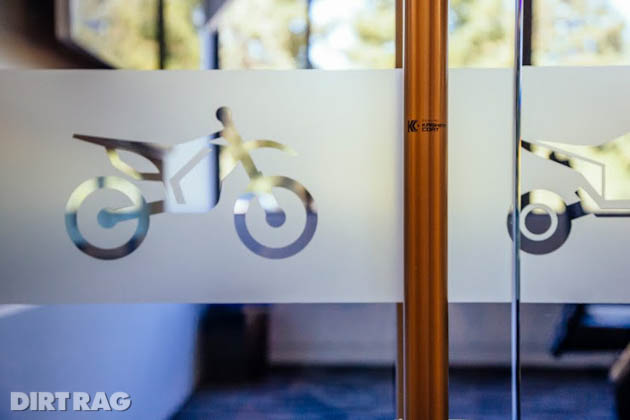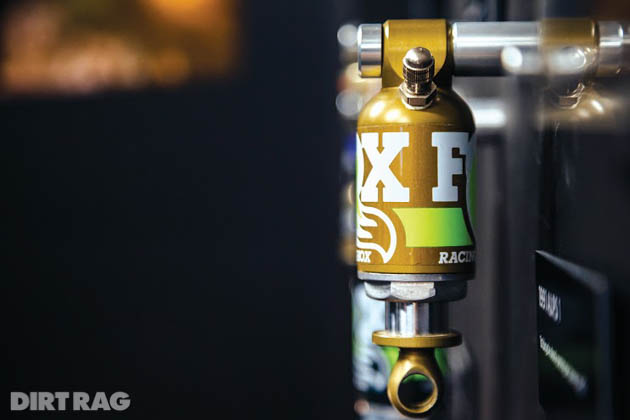In Print: Tale of the Fox—Inside the FOX Factory
Originally posted on December 9, 2014 at 14:03 pmEditor’s note: This feature originally appeared in Dirt Rag Issue #180. Order one here, or best of all, order a subscription and never miss an issue.
Words and photos by Jay Goodrich
It took me all of 15 minutes from the time I parked my rental car in the visitor’s spot at FOX in Scotts Valley, California, to create a lasting impression I wasn’t that proud of. Yes, I became “that guy.” Almost immediately after shaking hands with Global Communications Manager Mark Jordan, my guide for the day, I trashed the testing lab within FOX’s world headquarters. To get into the testing lab, you have to go through security clearance that rivals entry into Langley. Within this facility, guys with clean-shaven legs and 2 percent body fat hook forks and shocks up to a crazy network of custom-designed hydraulic-actuated machines designed to abuse the attached components and eventually find their breaking points.
These testing machines are given names like “Bashful,” “Sneezy,” and “Grumpy” so that the guys with the clean-shaven race legs can decipher which machine is testing which part. They can tell you how many compressions your brand-new 140mm 34 Float 29 fork will take before it needs to be serviced, but, better yet, also how many compressions and rebounds that puppy will take without any service before it becomes a piece of recycled metal.
It was in this lab that I, in one of my most embarrassing events, decided to trash the place. Without even a scratch to myself, I managed to knock over the entire dual-monitor computer system that was in control of all those custom-made machines of destruction. It’s safe to say that Grumpy was pissed that I made it stop working and is now aching to test out any one of the FOX forks attached to my quiver of custom bicycles. Fortunately, they are all at home in Wyoming and nowhere near this place.
Intelligently speaking
FOX recently relocated its headquarters to Scotts Valley to be closer to an environment that provides a network of trails for lunch rides and real-world testing for any idea they come up with. The headquarters house all of the day-to-day company operations, like design, marketing, material and assembly testing, a huge press room, a museum, and even a small machine shop. They took the building over from the Seagate hard-drive company, so some of the remaining colors and furniture ooze mid-’90s tech industry.
This leads me to the fact that everyone here seems to be really intelligent. We are talking IQs that rival the neighboring geeks of Silicon Valley. The difference here is that with muscled legs, the aforementioned 2 percent body fat, and healthy diets of kale salad for lunch after an hour ride, they would probably kick the physical crap out of 95 percent of those Apple folks.
As you enter the museum, you realize that within the intelligent engineering side of life lies a creative mastery of all things that get air or travel really fast. The mid-’90s paint and furniture has been replaced with a super-clean, modern layout that rivals any L.A. architect’s best project. Even the door handles utilize the upper legs of their new 40 triple-clamp downhill mountain bike fork.
FOX was started by Bob Fox, an amateur motocross racer, in 1974 to solve a problem with the suspension on his motorcycle: too little travel and a poor spring rate with that travel. As Fox designed the first FOX AirShox, he concluded, “I learned that I loved racing, I loved competition, and I loved using math, physics, and engineering to help get an edge.”
Within months he had a working prototype built by hand on a friend’s manual lathe in a garage, and within a year he began production and sales of the FOX AirShox. His first year produced 200 units, but also worked through an improvement process. The desire to always improve became the core mantra for the business: “Enthusiast employees who have technical backgrounds come together to create solutions. ‘Good enough’ is not part of our vocabulary.”
About the tail
When Bob Fox began producing his AirShox, he was part of his brother Geoff’s company Moto-X, but within three years the AirShox division became so successful that Bob chose to buy out his brother and create a separate and new company: FOX Factory, Inc. Bob often states that his brother got the head of the business and he got the tail of the business when his newly created logo became the word “FOX” with a bushy red foxtail originating from the letter “O.”
The two brothers’ connection did not end at this point. Geoff was continuously selling the FOX Factory products through the Moto-X catalogue and through the dealer network that was already in place. Success and notoriety came quickly with a bunch of wins within the motocross industry. These wins led to further expansion throughout the motorsports marketplace. Snowmobiles, ATVs, UTVs, trophy trucks, and even a brief stint into Formula One at the Indy 500 led to even more industry successes and increased equity to add to research and design development.
Bob Fox truly wanted to keep his company’s philosophy within the dirt arena and not let it stray to the road-racing marketplace, although legendary car drivers such as Mario Andretti came knocking and, in turn, purchasing. As the popularity of off-road motorsports grew, so did the off-road bicycle market. FOX entered the mountain bike marketplace in 1991 with a rear shock named the ALPS 1. This shock never made it to production, but it was the steppingstone to the following year’s ALPS 2, the world’s first production bicycle shock. This then led to Cannondale spec’ing a FOX air-sprung shock for their 1993 Super V full-suspension mountain bike. Almost every year from there on out, there were innovations pouring out of FOX with regard to full-suspension shock technology.
A decade after introducing the first full-suspension air shock, FOX decided to tackle the front-suspension market as well. In 2001, FOX realized they had the technology, engineering, and resources to produce their first high-end mountain bike fork. Enter the Float and Vanilla fork models; the Float was air sprung while the Vanilla was coil sprung. It took the company all of five years to become the dominant force in the high-end mountain bike fork market.
Entering current timelines, FOX’s mountain bike shocks and forks now dominate its production and revenue stream. Being a top contender in mountain biking market share doesn’t mean that the rest of their production is going by the wayside, either. They continue to produce suspension products for most off-road racing markets, developing concepts like their Kashima reduced-friction coating and even producing OEM shocks for the Ford Raptor pickup trucks since 2010. With close to 1,000 employees and multiple facilities throughout North America, Europe, and Asia, it is safe to say that this company is here to stay.
Machines and the candy store
After my testing-facility debacle (again, sorry, Grumpy), we were off to the machine shop and then the production facility. Growing up with a father who was responsible for production in a machine shop, I felt completely at home with the noise, grease, and metal. The shop, right down the street from FOX world headquarters in Scotts Valley, produces most of the raw parts that go into the fork and shock assemblies. This place houses 45 CNC machines that run 24 hours a day, six days a week, with three separate shifts of machinists to keep up with the demands of FOX’s production facility in Watsonville, California. The parts they are producing here are milled to 1/10,000 of an inch in most cases.
After lunch, Jordan took me to the production facility. This place simply translates into a candy store for anyone who’s into putting FOX products on their mountain bike or off-road motorsports rig. There are rows and rows of products all in the process of heading to worldwide destinations after a small waiting period of one or two shifts for quality control. This facility, in similar fashion to the machine shop, operates 16 hours a day with two separate eight-hour shifts of technicians. Since the mountain bike industry is the largest revenue stream here, it occupies the largest space. With two separate assembly lines, one for forks and the other for shocks, final pieces roll off at a pace of about one completed component every 30 to 60 seconds. As you watch the process, you feel as if you are watching a car being built, although the timeframe is a mere fraction of what an automobile takes.
All the batches have random selections that are checked within the quality-control lab. That lab houses a machine made by Zeiss that is accurate to some crazy ten-thousands-of-an-inch number. This machine will 3-D model/measure any part that FOX produces to verify that it works within the engineers’ specified tolerances. If the random check doesn’t meet specs, everything is shut down to figure out why. This gives FOX the confidence that they are following their “beyond good enough” mantra all the way into the hands of their customers.
Time to ride
I spent an entire day in California touring just a portion of what FOX has going on. I got to see things that would force me to kill you if I told you about them, and even managed to shoot some photos that I was politely asked to delete. I was force fed more info on the fly than I have ever encountered. FOX is now celebrating its 40th year and the future looks to last even longer for this technology-based engineering company that focuses on helping us play in the proverbial sandbox.
Update
After this story was published, we learned that FOX had agreed to acquire Race Face and Easton Cycling, vastly expanding its portfolio and likely giving it more standing as an OE supplier.







